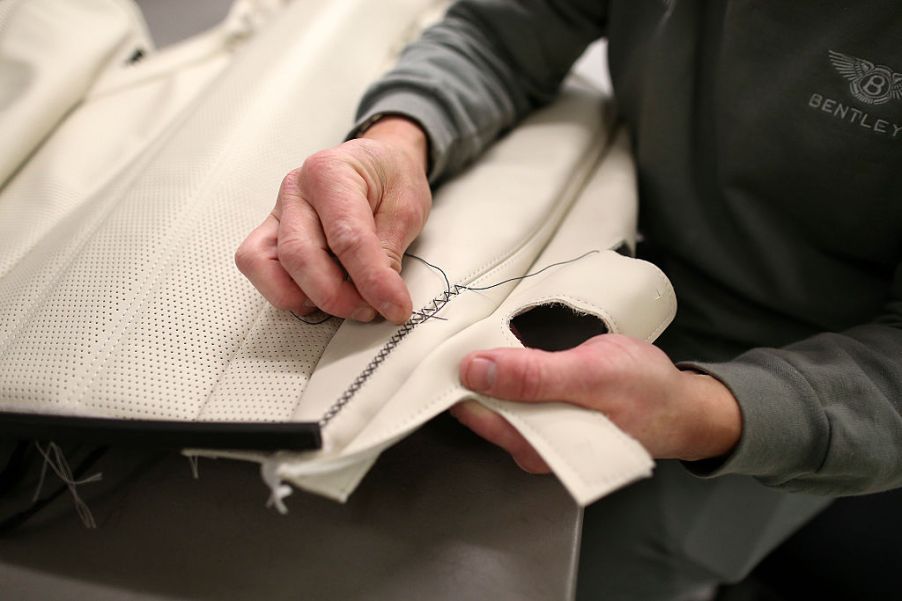
Easy Ways to Repair a Tear in Your Car’s Upholstery
Every car owner wants their vehicle to look its best. When your interior starts to get run down or damaged, it can put a severe damper on not just your car’s aesthetics, but also the pride you feel about your car. But when your car’s upholstery is scratched, scuffed, torn, or ripped, having a professional do the repairs can be costly.
What if you could repair your car‘s upholstery yourself? Before spending the money on costly repairs, try these easy fixes for repairing the upholstery in your car.
Tips for repairing a tear in cloth upholstery
Cloth upholstery is the easiest of car fabrics to work with when it comes to repairs. Tears, rips, and holes can be repaired at home with the right supplies and instruction. Here are a few ways you can try to repair a variety of cloth upholstery problems:
Simple tears
For tears that aren’t so big, you can put your sewing skills to use. Grab a curved, durable, upholstery needle from the store. Then get some extra-strong thread that is designed for upholstery and thick fabrics. When choosing your thread, pick one that matches the color of your upholstery.
Double-thread your upholstery needle with your durable thread to ensure your stitches will hold firmly. Begin at one side of the tear, roughly 1/2-inch away from where the tear begins. Place your needle under the fabric and bring the needle up through the fabric. Continue alternating your stitches on either side of the tear, under and over, bringing your needle through the fabric. According to LoveToKnow, you should try to keep your stitches at least a 1/4-inch away from the edges of the tear as you sew.
When you’ve reached the end of the year, repeat a stitch in the same spot between five and eight times to create a knot. Trim off the excess thread close to the fabric. Then, use a fabric sealant to paint along the edges of your stitches and the tear to keep it from ripping again or tearing.
Small holes
For smaller holes, two inches or smaller, you can easily patch your own cloth upholstery. Holes caused by cigarette burns, animal claws, etc. can be fixed using a piece of fabric and specially-designed fabric adhesive that seals with the use of heat.
Find a small piece of fabric from the craft store that matches both the color and texture of your upholstery. Cut the fabric to fit over the hole, leaving a small amount on all sides to overlap. Cut an additional piece of fabric adhesive and place it directly inside the hole.
According to Nationwide, you should then place your new piece of fabric on top of the fabric adhesive inside the hole and use an iron to heat the materials up. Once hot, the fabric adhesive will mold seamlessly with the new piece of fabric, covering the hole completely.
Tips for repairing leather or vinyl upholstery
Leather
Leather is not as easily repaired as cloth upholstery. Because it is a much higher-quality fabric, it also takes much more to make repairs to it. But leather also typically comes with a protective top-coat.
This means that most minor scratches and scuffs do not go beyond the protective top-coat and can be repaired with a little detailing work. You’ll know if your leather is damaged beyond the top-coat if the leather’s color is completely removed within the damaged area.
Most scratches and scuffs in leather can be treated with a variety of products, like leather conditioning cream. This can be used with a rag, rubbed onto the damaged area, in slow, circular motions. In more severe cases, you may also use a spray, acrylic lacquer that can be used to restore the look of the leather.
Always choose products that match your car leather’s color. When working with leather, it is important to remember that it’s a fragile fabric. Take your time and do not overdo it.
According to wikiHow, even small rips and tears in leather can be fixed using specialized leather kits. After trimming the tear to make a clean working area, a backing cloth is placed inside of the tear. After setting it with glue (and letting it dry completely), a soluble, leather filler is used to fill in the gaps between the original leather and the new piece of fabric.
You’ll need to apply multiple coats of this filler, allowing it to dry completely in-between coats. Once it’s filled and dry, you can use grained paper to gently sand the area down. Once smooth, use a leather colorant to rub on top of the filler until it matches the color of your upholstery. Finally, cover with a leather sealant for good measure.
Vinyl
It is not as common in car upholstery as leather or cloth, but many cars have vinyl and it works a lot like leather when it comes to repairs. Vinyl repair kits can be used for small tears, cracks, and holes.
These kits include liquid vinyl, in a color that matches your original upholstery. This liquid vinyl can be applied to small, damaged areas, in thin coats. Once completely covered, grain papers are used to match the upholstery’s texture and heat must be applied to set it all permanently.
How to know your DIY limits
While doing upholstery repairs at home can certainly save you money, it may not be the best option for all types of damages. If you’re wanting your vehicle to look brand new for example, it should be important to note that all at-home repairs will show, if even only slightly.
For leather upholstery that is heavily damaged, repairs are better done by professionals. And if tears and damage extend to any part of the seat belts or other safety equipment, letting the professionals handle it is the better, and safer option.


